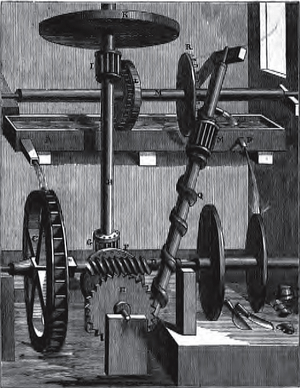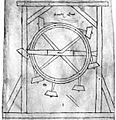Perpetual motion facts for kids
Imagine a machine that could run forever, all by itself, without needing any more fuel or power after you start it. That's what perpetual motion is all about! It's a movement that never stops.
People have dreamed of building such a machine for a very long time. But here's the catch: it goes against a basic rule of science called the conservation of energy. This rule says that energy can't be made out of nothing, and it can't just disappear. It can only change from one form to another, like from the energy in food to the energy you use to run.
Even though scientists have shown that these machines can't exist, inventors are still fascinated by them.
Contents
Types of Perpetual Motion Machines
Scientists have sorted perpetual motion machines into different types. Each type tries to break a different rule of how energy works, known as the laws of thermodynamics.
First Kind: Making Energy from Nothing
A perpetual motion machine of the first kind would create energy out of thin air. It would give its user endless free energy. This type of machine directly breaks the law of the conservation of energy. This law is a fundamental rule of physics. It says that the total amount of energy in a closed system stays the same. Energy can change forms, but it cannot be created or destroyed.
Second Kind: Perfect Heat Engines
A perpetual motion machine of the second kind would turn heat energy into useful work perfectly. Think of a car engine: it uses heat from burning fuel to make the car move. But real engines always lose some heat. They can't turn all the heat into motion.
These machines would violate the Second law of thermodynamics. This law says that heat naturally flows from hotter places to colder places. It also means that you can't turn all heat energy into useful work. Some energy will always be lost as unusable heat. A machine of the second kind would try to turn all heat into work, which is impossible.
Third Kind: Fighting Friction Forever
A perpetual motion machine of the third kind would be able to completely get rid of things like friction. Friction is the force that slows things down. It also includes air resistance. Because of friction, all real machines eventually stop.
If you could build a machine with absolutely no energy loss, it would keep moving forever. This idea goes against the third law of thermodynamics. This law says that it's impossible to reach absolute zero temperature. It also implies that some energy loss is always present in real systems.
Even if such a machine could be built, it wouldn't create new energy. It would only store the energy it started with. For example, a super-smooth spinning wheel would eventually slow down if you tried to use its motion for anything. You would only get out the energy you put in at the start.
Images for kids
-
An early idea for a perpetual motion machine by Villard de Honnecourt (around 1230).
-
Perpetual motion wheels from a drawing by Leonardo da Vinci.
See also
 In Spanish: Móvil perpetuo para niños
In Spanish: Móvil perpetuo para niños






